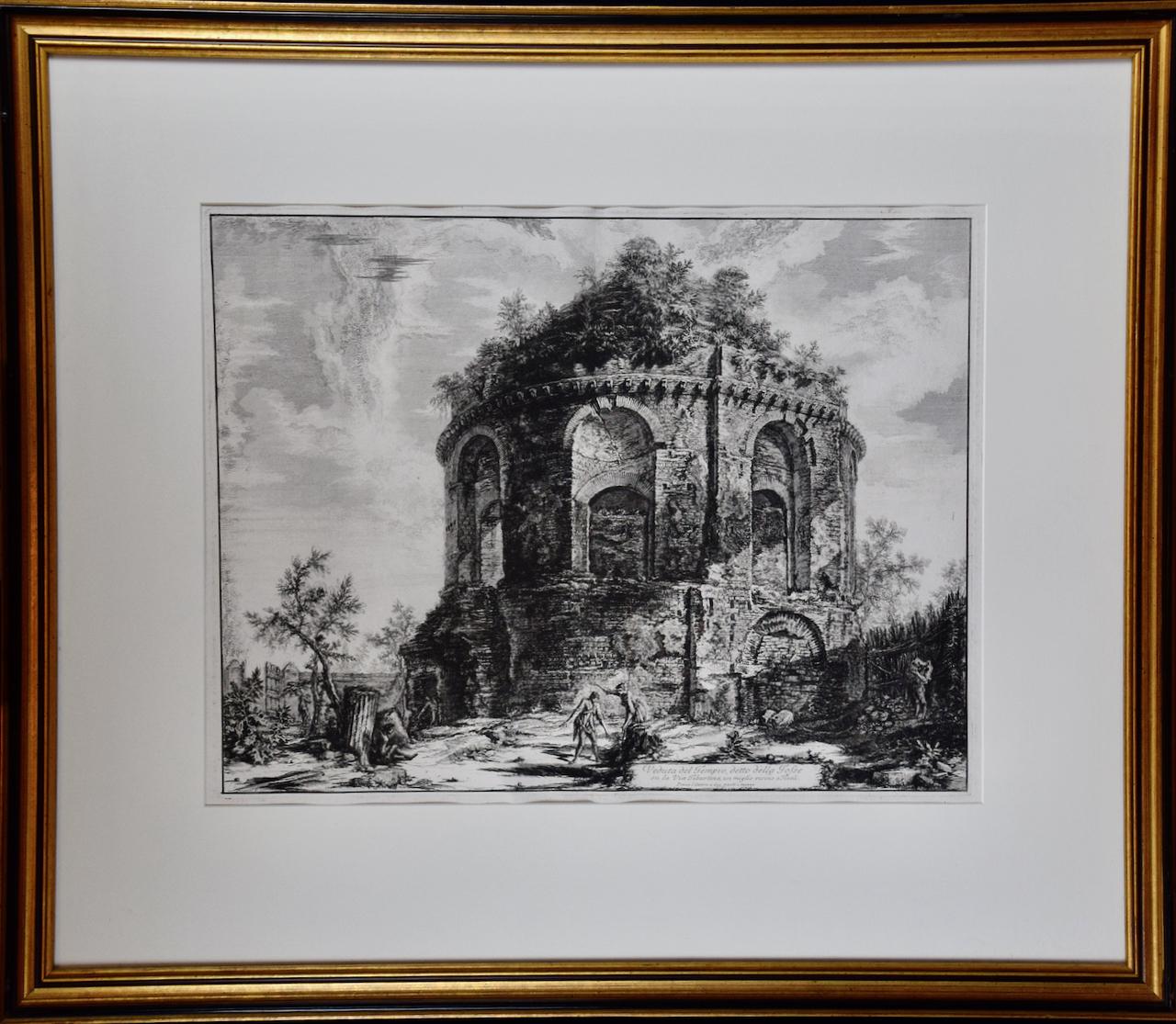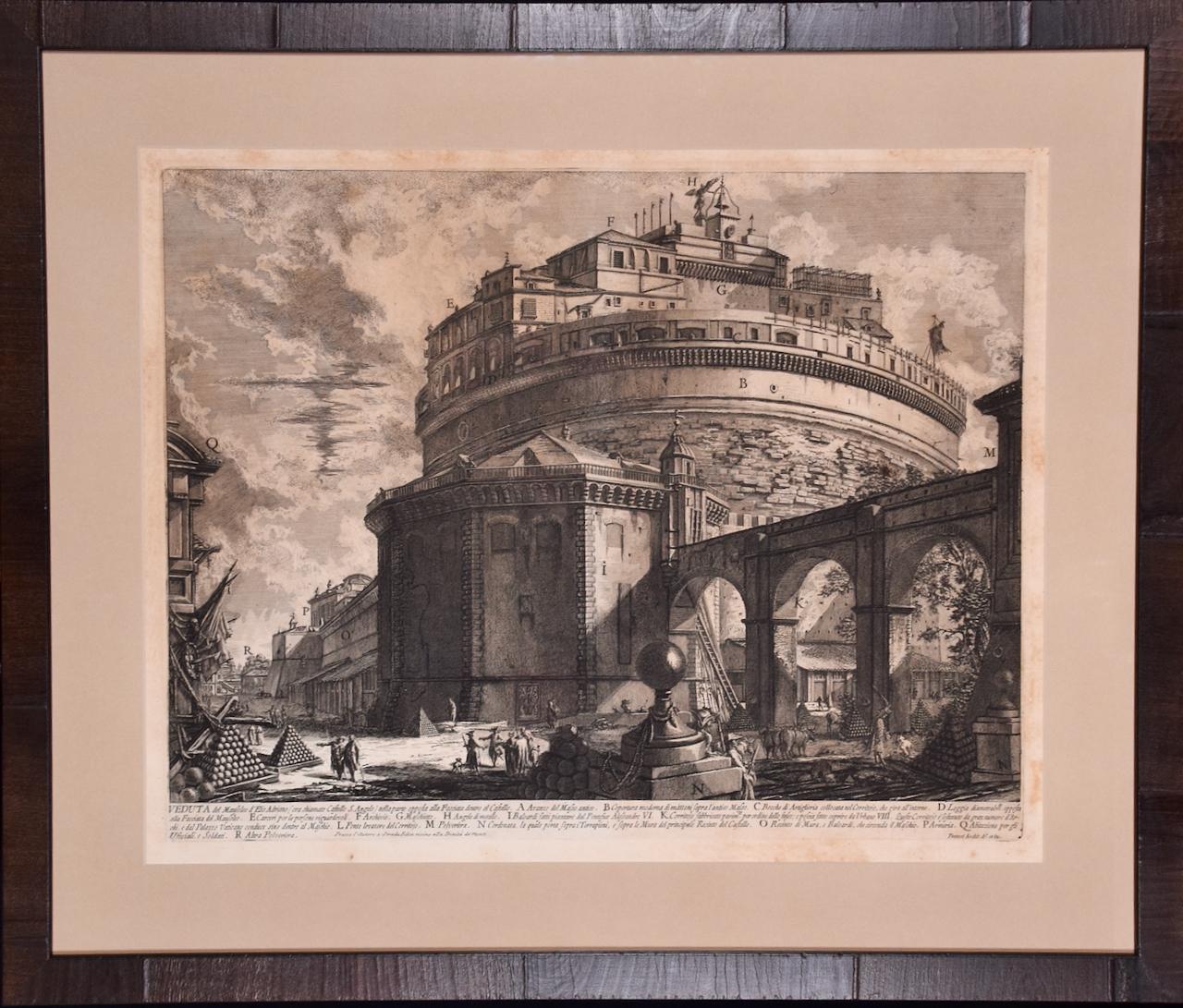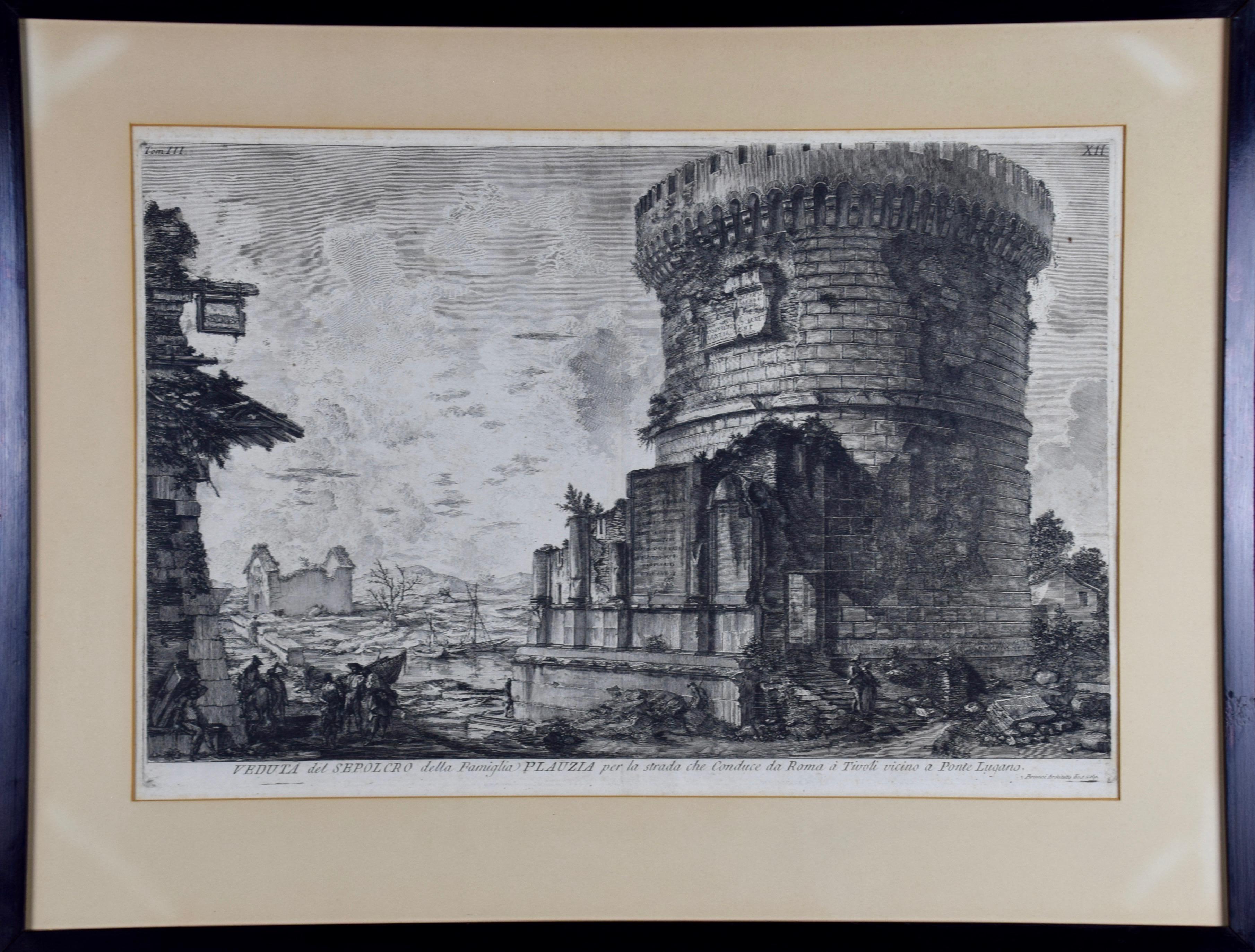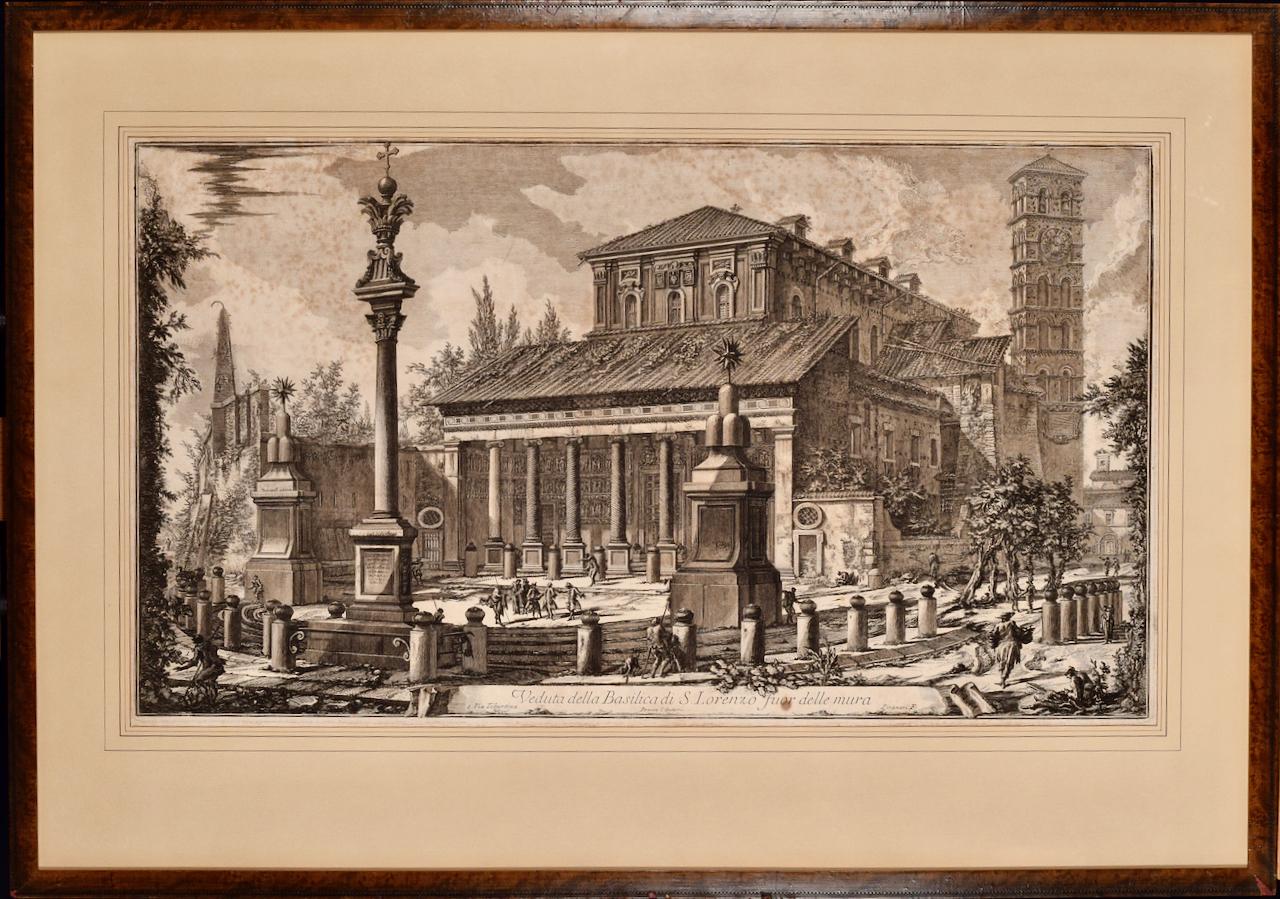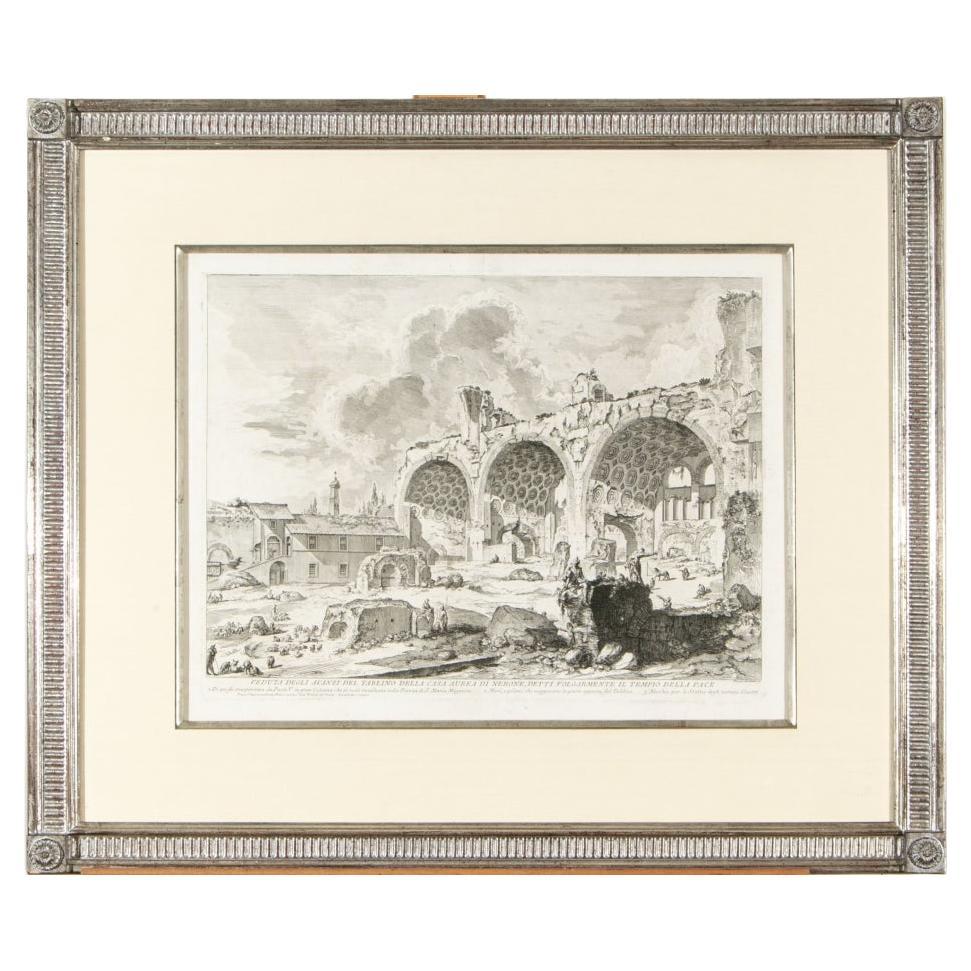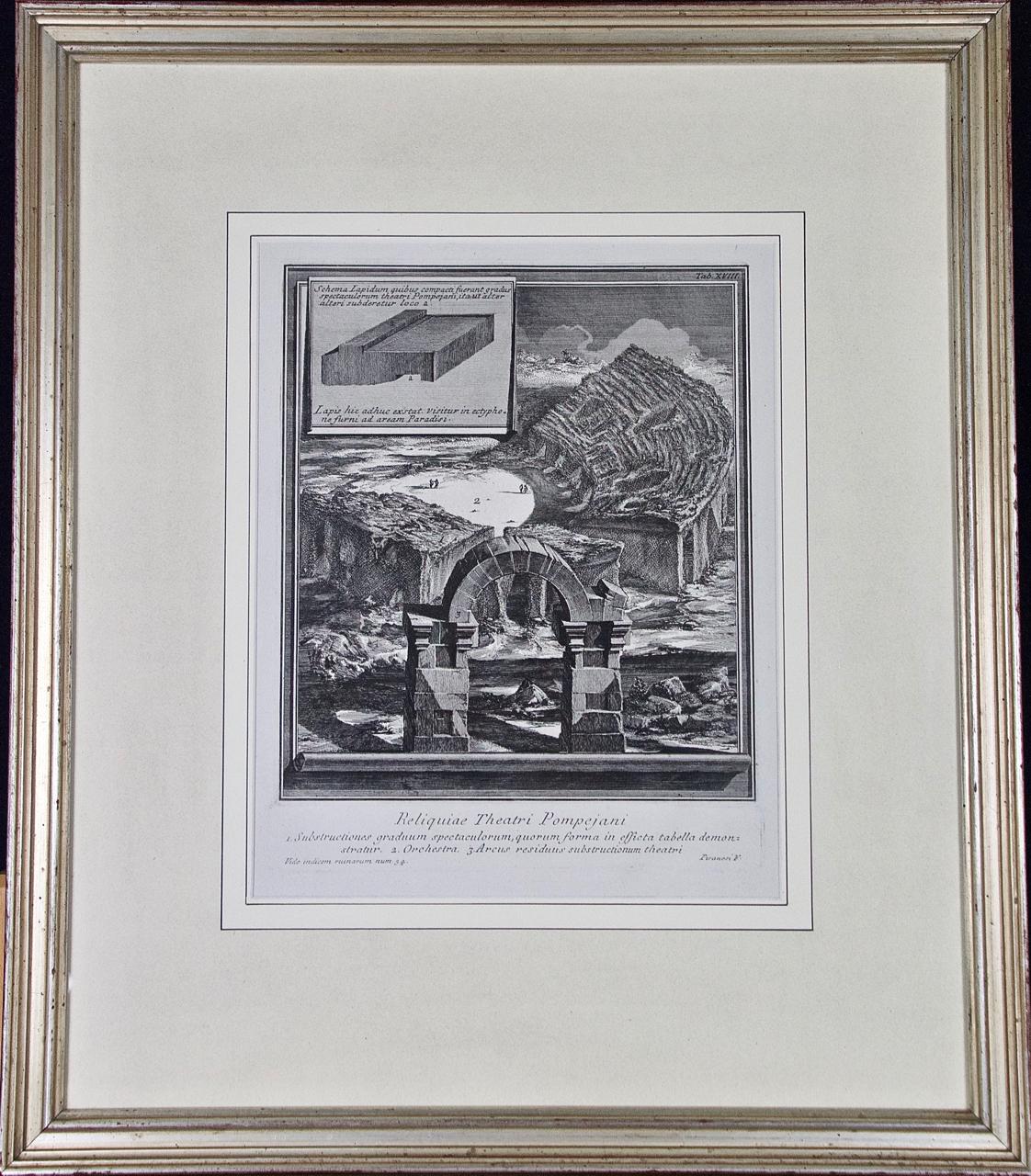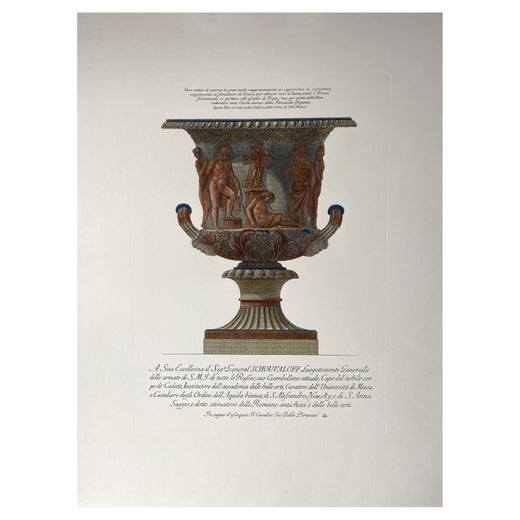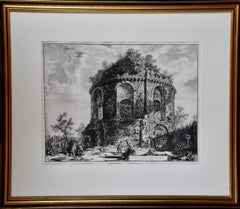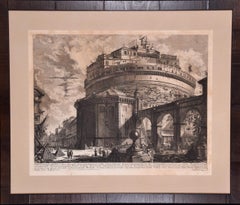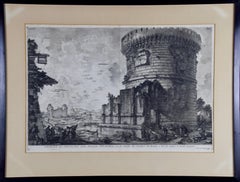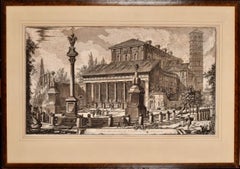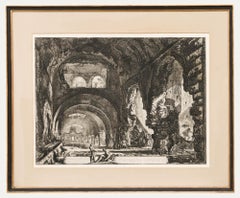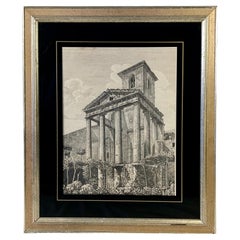Items Similar to The Roman Colosseum: A Framed 18th Century Etching of the Interior by Piranesi
Want more images or videos?
Request additional images or videos from the seller
1 of 15
Giovanni Battista PiranesiThe Roman Colosseum: A Framed 18th Century Etching of the Interior by Piranesi1766
1766
$5,875
£4,433.70
€5,075.92
CA$8,285.70
A$9,096.66
CHF 4,745.75
MX$110,082.28
NOK 59,480.59
SEK 56,046.35
DKK 37,890.37
About the Item
This large framed 18th century etching by Giovanni Battista Piranesi entitled "Veduta dell'interno dell'Anfiteatro Flavio detto il Colosseo" (View of the interior of the Flavian Amphitheater known as the Colosseum), was published in Rome in 1766 in Piranesi's monumental work 'Vedute di Roma' (Views of Rome). This etching depicts the interior of the famous ancient Roman colosseum. The way Piranesi chose to illustrate the state of disrepair of the architecture of this wonderful and historically important ancient structure in a way reflects his concern for the decay of many of Rome's monuments and landmarks. This situation was a motivating factor for him to document the appearance of Rome's ancient architecture with his etchings, before there was further deterioration of these magnificent structures. Piranesi chose to jar our senses by selecting a perspective of the Colosseum's interior which places structures in the foreground, like the column of stone in the center and the tall overgrown structure on the right, that disrupt the pleasing symmetrical order of the small archways on the far right. The casual neglect and disrespect of the local Romans for the Colosseum is further communicated by Piranesi when he includes scenes of animals grazing within the building, fallen blocks of stone laying on the ground and vegetation growing out of portions of the structure. People, some ordinary Romans and others possibly tourists on the Grand Tour, wander about the grounds. Some of these individuals are in casual conversation, like the two men adjacent to the stone slab in the lower left, which contains the title of the piece, one leaning against the structure. The peaceful scene is in sharp contrast to the earlier violent battles of the gladiators in this very same spot. Piranesi's name appears in the lower margin on the right.
This Piranesi etching is held by many museums and institutions, including: The Metropolitan Museum, The British Museum, The National Gallery of Art, The Harvard Museum of Art, and The Portland Art Museum.
This magnificent etching is printed on heavy laid, chain-linked, deckle edge paper. It is presented in a brown-colored wood frame and a gray mat. It is glazed with UV conservation glass. All mounting materials used are archival. The frame measures 28.88" high by 37.25" wide by 1.25" deep. There is a central vertical fold, as issued. The print is in very good condition.
Piranesi began collecting, restoring and selling ancient architectural objects in the 1760's in partnership with Thomas Jenkins and Gavin Hamilton, who had financed numerous excavations in the Pantanello area of Hadrian’s Villa at Tivoli. In 1768 Piranesi began creating etchings depicting these objects. The plates were eventually published together as a set in 1778 in "Vasi, Candelabri, Cippi, Sarcofagi, Tripodi, Lucerne ed Ornamenti Antichi". Piranesi dedicated many of the plates to patrons, colleagues, good customers and influential people. Many of the antiquities shown in Vasi were eventually sold to King Gustav III of Sweden by Piranesi's son, Francesco Piranesi, after his father’s death, and now reside in the National Museum in Stockholm.
Piranesi was born in Venice in 1720 and died in Rome in 1778. He was the son of a stone mason and was trained as an architect. After a slow start he eventually achieved great success as an architect, archaeologist, artist, designer, collector, and antiquities dealer. His mission was to glorify the architecture of ancient Rome through his engravings and etchings. His highly dramatized prints often depict imaginary interiors and frequently include figures in mysterious activities, who are dwarfed by the magnitude of their monumental surroundings. Piranesi was knighted by the Pope in 1765 and he was elected a Fellow of the Society of Antiquaries in England in 1757. Piranesi's style greatly influenced the neoclassical art movement of the late 18th century. His dramatic scenes inspired generations of set designers, as well as artists, architects and writers. His prints have continued to increase in value to institutions and collectors.
References:
Wilton-Ely 1994 211
Focillon 1918 760
Hind 1922 78
- Creator:Giovanni Battista Piranesi (1720-1778, Italian)
- Creation Year:1766
- Dimensions:Height: 28.88 in (73.36 cm)Width: 37.25 in (94.62 cm)Depth: 1.25 in (3.18 cm)
- Medium:
- Movement & Style:
- Period:1760-1769
- Condition:
- Gallery Location:Alamo, CA
- Reference Number:Seller: # 36851stDibs: LU117329953382
Giovanni Battista Piranesi
Piranesi was born in Venice in 1720 and died in Rome in 1778. He was the son of a stone mason and was trained as an architect. After a slow start he eventually achieved great success as an architect, archaeologist, artist, designer, collector, and antiquities dealer. His mission was to glorify the architecture of ancient Rome through his engravings and etchings. His highly dramatized prints often depict imaginary interiors and frequently include figures in mysterious activities, who are dwarfed by the magnitude of their monumental surroundings. Piranesi's style greatly influenced the neoclassical art movement of the late 18th century. His dramatic scenes inspired generations of set designers, as well as artists, architects and writers. His prints have continued to increase in value to institutions and collectors.
About the Seller
5.0
Gold Seller
Premium sellers maintaining a 4.3+ rating and 24-hour response times
Established in 2011
1stDibs seller since 2019
292 sales on 1stDibs
Typical response time: 1 hour
- ShippingRetrieving quote...Shipping from: Alamo, CA
- Return Policy
Authenticity Guarantee
In the unlikely event there’s an issue with an item’s authenticity, contact us within 1 year for a full refund. DetailsMoney-Back Guarantee
If your item is not as described, is damaged in transit, or does not arrive, contact us within 7 days for a full refund. Details24-Hour Cancellation
You have a 24-hour grace period in which to reconsider your purchase, with no questions asked.Vetted Professional Sellers
Our world-class sellers must adhere to strict standards for service and quality, maintaining the integrity of our listings.Price-Match Guarantee
If you find that a seller listed the same item for a lower price elsewhere, we’ll match it.Trusted Global Delivery
Our best-in-class carrier network provides specialized shipping options worldwide, including custom delivery.More From This Seller
View AllAncient Roman Temple Architecture: An 18th Century Framed Etching by Piranesi
By Giovanni Battista Piranesi
Located in Alamo, CA
This is an 18th century etching by Giovanni Battista Piranesi entitled "Veduta del Tempio detto della Tosse su la Via Tiburtina, un miglio vicino a Tivoli" (View of the so-called Tem...
Category
1760s Old Masters Figurative Prints
Materials
Etching
Hadrian's Mausoleum, Castel S. Angelo: A Framed 18th Century Etching by Piranesi
By Giovanni Battista Piranesi
Located in Alamo, CA
This large framed 18th century etching by Giovanni Battista Piranesi entitled "Veduta del Mausoleo d'Elio Adriana ora chiamato Castello S. Angelo nella parte opposta alla Facciata de...
Category
1750s Old Masters Landscape Prints
Materials
Etching
Ancient Roman Architecture: Original Framed 18th C. Etching by G. Piranesi
By Giovanni Battista Piranesi
Located in Alamo, CA
"Veduta del Sepolcro della Famiglia Plauzia per la Strada Che Conduce da Roma a Tivoli vicino a Ponte Lugano" from "Le Antichità Romane" (Roman Antiquities), one of the most famous works by Piranesi. "Antichita" illustrates the tombs along the Appian Way...
Category
Early 18th Century Old Masters Figurative Prints
Materials
Etching, Engraving, Drypoint
Basilica of San Lorenzo in Rome: A Framed 18th Century Etching by Piranesi
By Giovanni Battista Piranesi
Located in Alamo, CA
This large framed 18th century etching by Giovanni Battista Piranesi entitled "Veduta della Basilica di S. Lorenzo fuor della mura" (Basilica of San Lorenzo Outside the Walls), published in Rome in 1750 in Piranesi's Vedute di Roma (Views of Rome), This etching depicts the Basilica of San Lorenzo Outside the Walls, which is a Roman Catholic papal basilica and parish church, located in Rome, Italy. The Basilica is one of the Seven Pilgrim Churches of Rome and one of the five "papal basilicas". It was built as a shrine to the martyred Roman deacon St. Lawrence.
This Piranesi etching is held by many museums and institutions, including: The Metropolitan Museum, The British Museum, The National Gallery of Art, The Yale University Art Gallery, and The Harvard Museum of Art.
This magnificent etching is presented in a brown-colored wood frame and a tan French...
Category
1750s Old Masters Landscape Prints
Materials
Etching
Piranesi 18th C. Etching "Reliquiae Theartri Pompejani" an Ancient Roman Theater
By Giovanni Battista Piranesi
Located in Alamo, CA
This a framed Giovanni Battista Piranesi (1720-1778) etching entitled "Reliquiae Theartri Pompejani" (Remains of the Theatre of Pompey) from "Il Campo Marzio dell'Antica Roma" (The Campus Martius of Ancient Rome), published in Rome in 1762. It depicts the remains of an ancient theater in Rome with exposed seating and an arch still standing in the foreground. An inset shows an architectural side view of a portion of the structure.
The etching is presented in an antiqued silver-colored wood frame with a cream-colored French mat. The frame measures 24" x 20.75" x 1.25". The print is in excellent condition.
The Theatre of Pompey (Latin: Theatrum Pompeii, Italian: Teatro di Pompeo) was a structure in Ancient Rome built during the latter part of the Roman Republican era by Pompey the Great...
Category
Mid-18th Century Old Masters Landscape Prints
Materials
Etching
Church of St. Costanza, Rome: An 18th Century Piranesi Architectural Etching
By Giovanni Battista Piranesi
Located in Alamo, CA
This is a framed 18th century Giovanni Battista Piranesi etching entitled: "Veduta interna del Sepocro di Santa Costanza, fabbricat...
Category
1770s Old Masters Interior Prints
Materials
Etching
You May Also Like
Giovanni Battista Piranesi, 18th C. Engraving, View Of The Ruins
By Giovanni Battista Piranesi
Located in Bridgeport, CT
Italian, 1720-1778. With an expected fold down the middle. View of the "Casa Aurea Nerone". From the "Veduta di Roma" series. Artist name in plate lower right.
Dimensions: sight 17...
Category
Antique 18th Century Italian Renaissance Prints
Materials
Glass, Wood, Paper
After Giovanni Battista Piranesi - Early 20th Century Etching, Villa of Maecenas
Located in Corsham, GB
A charming etching depicting Giovanni Battista Piranesi's Villa of Maecenas at Tivoli. Inscribed with artist name in plate. Presented in a black and gilt frame. On paper.
Category
20th Century Landscape Prints
Materials
Etching
View of the Interior of the Colosseum by Francesco Piranesi, 1835
By Francesco Piranesi
Located in New York, NY
Piranesi, Francesco.
Le Antichita Romane.
This plate: View of the interior of the Colosseum.
Hind 134, 1st Paris edition, 1835.
Original etching.
Plate size: 19 1/2 x 28 1/4 i...
Category
Early 19th Century Prints and Multiples
Materials
Paper
$1,800 Sale Price
28% Off
Giovanni Piranesi's "The Temple Of Hercules" Engraving, Framed
By Giovanni Battista Piranesi
Located in Bradenton, FL
The Temple of Hercules Is the only surviving sacred structure in ancient Rome that was made of Greek marble. Located in on the eastern bank of Tiber, it is one of the oldest extant buildings in the city. Giovanni Piranesi memorialized this structure in his famed monumental etchings. This large black and white print...
Category
Antique 19th Century Italian Neoclassical Prints
Materials
Paper
The Basilica of Constantine
By Giovanni Battista Piranesi
Located in Chicago, IL
A very fine impression of the 3rd State, still with the address and price which were eliminated in the following 4th state. The presence of the address and price confirms that this ...
Category
18th Century and Earlier Old Masters Landscape Prints
Materials
Etching
Plate VIII of Piranesi's 'Parere su l’architettura'
By Giovanni Battista Piranesi
Located in NYC, NY
Plate VIII from 'Observations on Architecture' by Giovanni Battista Piranesi (1720-1778)
The latin inscription reading “Pour ne pas faire de cet art sublime un vil métier où l’on ...
Category
Antique 19th Century European Prints
Price Upon Request
More Ways To Browse
S Thomas
Antique Stone Columns
Used Stone Slabs
Antique Stone Slabs
Horse With Jockey Paintings
Howard Finster Art
Hunt Slonem Hummingbirds
Irish Railway
J Gould And H C Richter Bird Lithograph
J S Bach
Joan Maier
Joe Durante
Jose Parla
Jules Heller
K Bruce
Keith Haring Stickers
Keith Haring Subway Drawings
Kusama Skateboard
